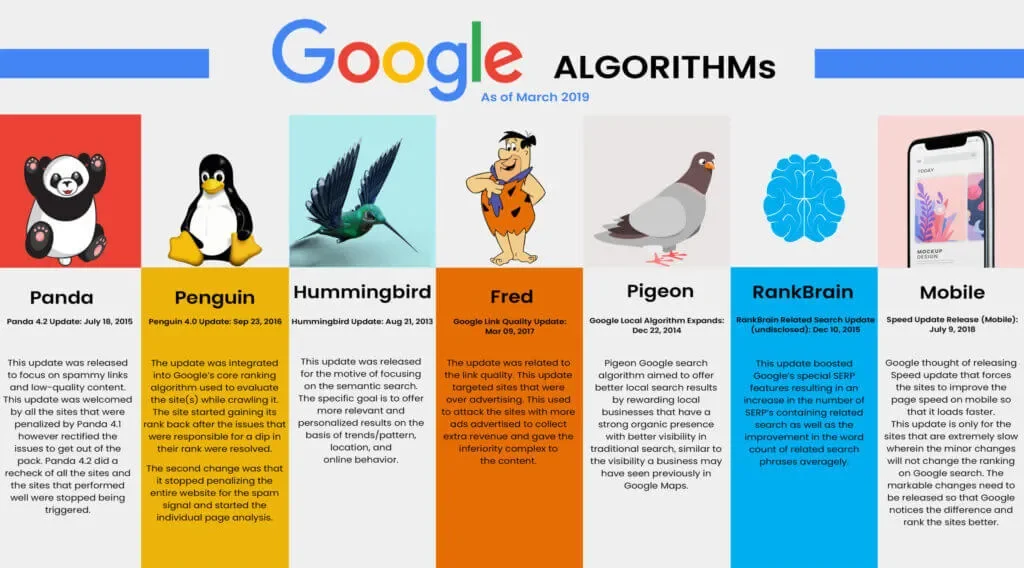The evolving nature of Google’s algorithms means small businesses must adapt quickly to stay relevant. If you’ve noticed fluctuations in your visibility recently, you’re not alone. Recent updates aim to improve user experience by providing more accurate and useful results based on relevance, proximity, and trustworthiness. While these changes can feel daunting, understanding their implications can empower business owners like you to refine your strategies for better performance. Ready to delve deeper into how you can secure a top spot on the map? Let’s explore practical insights that will help position your business for lasting success amidst this dynamic environment.
Understanding Google Maps Ranking Algorithms
To grasp how to improve your visibility on Google Maps, it’s essential to understand the mechanics of its ranking algorithms. At the core of these algorithms lies a sophisticated system designed to provide users with relevant and timely search results based on various factors. Primarily, Google assesses three main criteria: relevance, distance, and prominence. Relevance signifies how well a business matches the user’s query; for instance, if someone searches for a “vegan coffee shop,” a café with optimized listings featuring vegan options will likely rank higher than other general coffee shops.
Distance plays an equally pivotal role in determining local search results. Google considers the physical distance between the user’s location (or the point of interest they specify) and the businesses in question. A user searching for “pizza near me” is more prone to see listings that are geographically closer rather than those that are farther away—even if the latter might be deemed more prestigious or better rated according to other metrics. Thus, maintaining an optimized Google My Business (GMB) profile becomes crucial in aiding local SEO strategies—ensuring information like address and service area is accurate can significantly impact distance calculations.
Prominence rounds out this trifecta of factors, reflecting how well-known a business is both online and offline. This includes not just reviews but also backlinks from reputable sites and coverage from local listings outside GMB. For example, a bakery with glowing reviews on multiple platforms such as Yelp and Facebook—combined with articles about its artisan breads published by food blogs—demonstrates offline prominence while reinforcing online credibility. Therefore, when crafting local SEO strategies, ensuring you foster relationships within your community and garnering positive attention through various channels serves as foundational steps towards enhancing your overall prominence.
Understanding these fundamental components enables local business owners to approach their rankings proactively rather than reactively chasing after updates as they arise. By aligning time spent on optimizing relevance through targeted keywords, focusing on geographical reach through correct listings—and amplifying unique branding initiatives that resonate within the community—you create an integrated web of content that directly contributes to boosting your Google Maps ranking over time.
Recent Algorithm Changes and Their Implications
In recent years, Google has made several significant updates to its algorithms that directly impact how local businesses rank on Google Maps. One of the most notable changes came with the introduction of local ranking factors, where Google began giving more weight to user engagement metrics such as click-through rates and time spent on listings. For instance, if your business receives a high volume of clicks and positive interactions on your Google My Business (GMB) profile, it can result in improved rankings over competitors who may have higher domain authority but less customer engagement. This shift has profoundly changed the landscape for local SEO, making it essential for businesses to focus not just on listing accuracy, but also on enhancing their overall online presence.
Another critical update involved better personalization of search results based on individual user behavior and location history. This means that two users searching for a “coffee shop” in the same geographic area may see different rankings depending on their prior interactions with similar businesses or specific preferences they’ve expressed through previous searches. As a local business owner, this illustrates why delivering personalized customer experiences online is increasingly essential—not only does it help you stand out in crowded markets, but responding positively and promptly to consumer behaviors can lead directly to better visibility and awareness in service areas where competition is fierce.
The implications of these algorithm changes are substantial. Businesses that once relied solely on basic GMB optimization for visibility may find themselves needing to employ deeper strategies like enhancing website content relevant to their community or actively engaging with customers through social media platforms. Failing to adapt could mean losing precious placements in local search rankings, drastically affecting foot traffic both online and offline. It’s crucial for small business owners to understand these dynamic shifts; staying informed allows them not only to respond swiftly but also to capitalize on new opportunities created by these rankings adjustments.
In conclusion, adapting to Google’s ongoing algorithm updates is vital for maintaining strong business visibility within local search results. By embracing changes aimed at improving user experience—like fostering community connections or enhancing digital engagement—businesses not only position themselves favorably within Search Engine Results Pages (SERPs) but also capture the attention of potential customers looking for genuine services in their vicinity. Keeping an eye on these trends will empower local businesses to remain competitive and relevant even amidst frequent shifts in Google’s ranking strategies.
Common Pitfalls During Algorithm Updates
As small businesses navigate the ever-changing landscape of Google Maps rankings, it’s crucial to steer clear of common pitfalls that can hinder their visibility and overall success. One prevalent mistake is the reluctance to adapt swiftly to algorithm updates. For instance, when a local café fails to update its Google My Business (GMB) listing with new operating hours or an updated menu after a recent change in consumer trends or regulations, it risks losing customers who rely on accurate information. These simple oversights might seem trivial but can lead to disappointing foot traffic and diminished online presence.
Another frequent error is underestimating the significance of customer engagement. After algorithm changes, some business owners may assume that maintaining their GMB profile without actively seeking reviews or responding to customer inquiries is enough. This mistake can be particularly detrimental; local SEO intertwines closely with engagement metrics—businesses that overlook the importance of encouraging positive feedback or neglect responses may see their Google Maps ranking slip dramatically. Engaging with users fosters trust and credibility—both vital components for maintaining visibility in local search results.
Additionally, many small businesses fall into the trap of ignoring major competitive shifts during algorithm updates. Monitoring competitor rankings and strategies is essential; failing to do so can leave your business at a disadvantage when rivals capitalize on new opportunities from updates. If a competitor enhances their GMB listing with vibrant photos and responds proactively to customer reviews while you remain stagnant, they are likely to rise higher in Google Maps rankings at your expense.
To mitigate these pitfalls, it’s vital for business owners to stay informed about changes within the Google ecosystem, readily embrace necessary adjustments, engage consistently with customers, and diligently monitor competitors’ activity. By doing so, they position themselves favorably against those who underestimate the impact algorithm updates can have on their local search visibility.
Building a Strong Google My Business Profile
A well-optimized Google My Business (GMB) profile is foundational for enhancing your visibility on Google Maps, especially in light of recent ranking updates. Start by ensuring that all your business details—name, address, phone number (NAP), and business hours—are accurate and consistently formatted across platforms. Inconsistencies can confuse potential customers and diminish your credibility with Google’s algorithms. For instance, if you run a local bakery called “Sweet Treats,” ensure that it appears as “Sweet Treats” everywhere, without deviations such as “Sweet Treatz” or “The Sweet Treat Bakery.” This uniformity signals to search engines that your business is legitimate.
Engaging media content is another key component of an optimized GMB listing. High-quality photos of your products or services not only attract attention but also encourage customer interaction. Consider adding images showcasing the ambiance of your café alongside mouth-watering images of baked goods to appeal to sensory experiences. Video content can take this further by providing virtual tours or demonstrating how a product is made, enhancing user engagement while supporting the chances of higher rankings following updates in Google’s algorithm.
Additionally, utilize the “Posts” feature within GMB to keep your audience engaged with regular updates about promotions, events, or new offerings. By posting regularly—think about what deals you might have for upcoming holidays—you not only inform customers but show activity on your profile that could benefit ranking positions amidst continual algorithm changes. Engaging content indicates relevance and can translate to improved customer interactions; metrics like increased click-through rates signal to Google that users find value in your offering.
Lastly, don’t forget about obtaining reviews from satisfied clients. Positive feedback builds trust among potential customers while reaffirming your authority in the eyes of Google’s systems. Encourage patrons at the end of their experience to leave honest reviews by providing them with a simple link via email or SMS. These testimonials are vital not just for influence but for improving local rankings when search algorithms prioritize businesses with higher ratings and numerous active engagements. Ultimately, mastering these aspects can significantly enhance your GMB presence amid ongoing ranking updates and cement a strong foothold in the competitive local market space.
Local SEO Strategies to Boost Rankings
When it comes to improving your Google Maps ranking, focusing solely on your Google My Business (GMB) profile isn’t enough. A robust local SEO strategy is essential for achieving comprehensive visibility in local search results. One effective tactic for enhancing local search optimization is the use of local citations—mentions of your business name, address, and phone number (NAP) across online directories and platforms. By ensuring that your NAP information is consistent across various websites like Yelp, Yellow Pages, or industry-specific directories, you reinforce your credibility with search engines. This consistency signals reliability to Google, ultimately helping you climb higher in the rankings.
Beyond citations, backlinks play a crucial role in boosting your local authority. Securing links from reputable sources within your community can do wonders for your Google Maps ranking. For instance, if you’re a coffee shop collaborating with a local bakery for an event or promotion, ask them to link back to your website when they promote that event on their platform. Such partnerships not only establish connections within the community but also enhance the quality of your site’s outbound links—which can significantly influence how well you perform in local searches.
Another strategic approach involves creating localized content that resonates with your target audience. Writing blog posts about local events or topics relevant to your region helps attract organic traffic while providing opportunities for backlinks and citations through shares among community members and organizations. Furthermore, optimizing this content for geo-specific keywords enhances its relevance when users seek businesses like yours based on location. Providing valuable insights into both the community and industry elevates engagement while positioning you as an authority—ultimately cementing your place in the competitive landscape of local search optimization.
Investing effort into these tactics will amplify the effects of optimizing your GMB profile and position you favorably amid changing algorithm landscapes. Without strategically leveraging citations and high-quality backlinks tailored to meet the unique needs of customers searching locally, businesses risk falling behind competitors who are keenly aware of how to navigate these nuances effectively.
Monitoring Competitor Strategies
In the landscape of Google Maps rankings, keeping a close eye on your competitors can provide valuable insights and reveal potential gaps in your own strategy. Post-algorithm updates, it’s essential to analyze how competitors are adapting their approaches to remain visible and relevant. Start by identifying your direct competitors within your service area—those businesses that share the same target audience but may occupy varying positions in the search results. Observe their Google My Business (GMB) profiles for any changes. Are they posting more frequently? How are they managing customer engagement through reviews and responses? This kind of competitive analysis can expose successful tactics that you might consider incorporating into your own approach.
Utilizing specific tools can also enhance your ability to monitor competitor behavior effectively. Platforms like SEMrush or Ahrefs offer robust competitive analysis features that let you track keyword rankings, backlinks, and site performance metrics for local businesses within your niche. Using these tools, you can identify what keywords are driving traffic to their GMB listings or websites and adjust your SEO strategies accordingly. Furthermore, tracking changes over time gives you insights into trends — whether customers prioritize review counts or recent photos from the business can significantly impact user engagement.
Additionally, don’t underestimate the power of social media as a tool for observing competitor strategies. Follow them on platforms like Facebook, Instagram, or LinkedIn to see how they engage with their audience beyond their GMB profile. Attentively analyzing their content—such as promotions they run or community posts—can be exceptionally beneficial in understanding what resonates with local customers currently searching for products or services similar to yours. By blending traditional competitive analysis methods with contemporary digital monitoring tools, you position yourself not only as a reactive player but as an informed strategist in the constantly evolving world of local SEO.
Finally, remember that benchmarking against your competitors isn’t just about imitation; it’s about innovation too. Use the gathered data from these analyses to carve out unique selling propositions (USPs) for your business offerings that set you apart in a crowded marketplace and allow you to take proactive measures towards maintaining strong Google Maps visibility post-update.
Embracing Customer Engagement & Reviews
In the realm of Google Maps rankings, customer reviews play a pivotal role in determining a business’s visibility. When potential customers search for local services or products, they are often swayed by the experiences shared by others. A high quantity of positive reviews not only enhances your business’s reputation but also signals to Google that your establishment is both relevant and trustworthy. For instance, a coffee shop with multiple glowing testimonials highlighting exceptional service and quality will likely rank higher than a lesser-reviewed competitor, even if both offer similar products.
To harness the power of reviews effectively, consider implementing engaging customer engagement tactics that proactively invite feedback. One successful strategy is sending follow-up emails after a purchase or service, thanking customers for their patronage while encouraging them to share their thoughts online. Additionally, consider creating visually appealing review cards that can be handed out during transactions or placed in strategic locations within your storefront. These cards can include QR codes that link directly to your Google My Business review page, making it easy for satisfied customers to leave their feedback instantly.
Moreover, actively responding to reviews—both positive and negative—is crucial in building rapport with your customer base. By acknowledging compliments and addressing concerns openly and professionally, businesses demonstrate their commitment to customer satisfaction. This engagement not only strengthens relationships but subtly prompts more patrons to share their experiences as well. Successful restaurants often showcase examples like this; they reply promptly to testimonials on platforms like Yelp or Google Reviews—turning one-time visitors into loyal advocates through simple acknowledgment.
Ultimately, don’t underestimate the significance of fostering an environment where customers feel valued and heard encourages organic growth in your review count—and therefore boosts your Google Maps ranking. By prioritizing these practices around customer engagement and consistently seeking constructive feedback, small business owners can create a thriving community that enhances both visibility and credibility within local search results.
Adapting Your Business Approach Post-Update
Once a Google algorithm update rolls out, the immediate step for local business owners is to evaluate their performance metrics closely. Tools like Google Analytics and Google My Business Insights can provide valuable data on how your visibility has shifted following an update. For instance, if you notice a significant drop in your search impressions or calls through Google Maps, it’s crucial to dig deeper to understand which aspects of your online presence may need attention. Monitoring these trends not only helps identify problems but also lays the groundwork for strategic adjustments that can lead to recovery or improvement in rankings.
Based on the insights gained from analyzing performance metrics, it’s time to pivot your marketing strategies accordingly. If you’ve found that specific keywords have declined in effectiveness, consider recalibrating your location-based marketing efforts by optimizing for phrases more relevant to your target audience. For example, if “best pizza delivery” no longer serves as a traffic-driving term due to changing customer preferences post-update, you might want to shift focus toward “family-friendly pizzeria near me.” This approach not only aligns with emerging search trends but can also help keep you competitive in the local market.
Moreover, understanding customer behavior post-update can further inform your content strategy and promotional tactics. If user engagement with certain types of content—like photos of family gatherings at your restaurant—has increased during this period, delve into creating more similar content that resonates with your audience. By highlighting what makes your business unique while adapting to changes in consumer language and expectations, you’ll strengthen your overall digital footprint and appeal when customers turn to Google Maps for local searches.
In conclusion, adapting effectively after an algorithm change involves more than just reactive measures; it requires ongoing analysis and strategic foresight. By continuously evaluating performance metrics and leveraging those insights into your marketing strategies—especially within the realm of location-based marketing—you position yourself favorably amidst shifting digital landscapes. Remember that agility is just as essential as accuracy; stay proactive about refining what works best for connecting with local customers while keeping an eye toward future updates.
Conclusion: Staying Ahead in the Game
Mastering your Google Maps ranking is crucial for boosting your local business visibility. In this article, we discussed the importance of understanding how Google Maps algorithms work and highlighted recent algorithm changes that could impact your standings. We also emphasized building a strong Google My Business profile, adopting effective local SEO strategies, and engaging with customer feedback.
Now more than ever, staying proactive is essential. Regularly monitor competitor strategies and adjust your approach based on performance data. By being adaptable and focused on best practices, you can thrive amid ongoing changes to Google’s algorithms. Keep fine-tuning your tactics to ensure you stay ahead in this competitive landscape!




